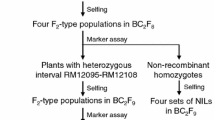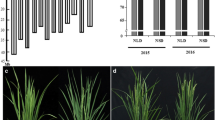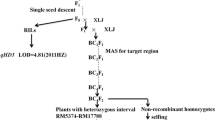Abstract
Flowering time or heading date in rice is an important agronomic trait that determines cultivation area and cropping season of a given variety. The genes/loci that have minor effect on the heading date are believed to play a critical role in adaptation of rice to different geographical regions and are preferred by breeders. Previously, we detected a stable minor-effect quantitative trait locus, qDTH-3b (for Days to heading 3b; hereafter referred to as DTH3b), using a small population consisting of recombinant inbred lines derived from a cross between the japonica cv. Asominori (Aso) and the indica cv. IR24. However, its precise location remains to be defined. In this study, we fine-mapped DTH3b by using advanced backcrossing lines and explored its role in regulating the heading date. First, we constructed a BC4F2 population by backcrossing a chromosome segment substitution line (CSSL23) with Aso as a recurrent parent. Then, we developed a near-isogenic line (NIL) from this population by marker-assisted selection. This NIL has the genetic background of Aso but carries a 12-cM DTH3b-containing chromosome segment from IR24. Compared with Aso, the NIL showed 6.9-day delay in flowering time and 63.8 % lower seed maturation rate under long-day (LD) conditions, whereas there was no significant difference between the NIL and Aso under short-day conditions. Using a total of 1500 Asominori/NIL F2:3 or F3:4 late-heading families grown under LD conditions, we finally dissected DTH3b to a single Mendelian factor and delimited it to a 46-kb genomic region which contains seven open reading frames. Further, our quantitative real-time PCR analysis indicated that transcription level of Hd3a (Heading date 3a) and RFT1 (RICE FLOWERING LOCUS T 1), the two florigen genes, was significantly lower in the NIL than in Aso, suggesting that DTH3b functions upstream of Hd3a and RFT1 under LD conditions. We propose that DTH3b Aso positively regulates flowering time and contributes to adaptation of rice to the north. Cloning and then manipulation of DTH3b can be a useful approach to optimize flowering time in rice breeding.




Similar content being viewed by others
References
Bian X, Liu X, Zhao Z, Jiang L, Gao H, Zhang Y, Zheng M, Chen L, Liu S, Zhai H, Wan J (2011) Heading date gene, dth3 controlled late flowering in O. Glaberrima Steud. by down-regulating Ehd1. Plant Cell Rep 30:2243–2254
Blumel M, Dally N, Jung C (2015) Flowering time regulation in crops—what did we learn from Arabidopsis? Curr Opin Biotechnol 32:121–129
Chen J, Li X, Cheng C, Wang Y, Qin M, Zhu H, Zeng R, Fu X, Liu Z, Zhang G (2014) Characterization of epistatic interaction of QTLs LH8 and EH3 controlling heading date in rice. Sci Rep 4:4263
Cockram J, Jones H, Leigh F, O’Sullivan D, Powell W, Laurie D, Greenland A (2007) Control of flowering time in temperate cereals: genes, domestication, and sustainable productivity. J Exp Bot 58(6):1231–1244
Doi K, Izawa T, Fuse T, Yamanouchi U, Kubo T, Shimatani Z, Yano M, Yoshimura A (2004) Ehd1, a B-type response regulator in rice, confers short-day promotion of flowering and controls FT-like gene expression independently of Hd1. Genes Dev 18:926–936
Gao H, Zheng X, Fei G, Chen J, Jin M, Ren Y, Wu W, Zhou K, Sheng P, Zhou F, Jiang L, Wang J, Zhang X, Guo X, Wang J, Cheng Z, Wu C, Wang H, Wan J (2013) Ehd4 encodes a novel and Oryza-genus-specific regulator of photoperiodic flowering in rice. PLoS Genet 9:e1003281
Gao H, Jin M, Zheng X, Chen J, Yuan D, Xin Y, Wang M, Huang D, Zhang Z, Zhou K, Sheng P, Ma J, Ma W, Deng H, Jiang L, Liu S, Wang H, Wu C, Yuan L, Wan J (2014) Days to heading 7, a major quantitative locus determining photoperiod sensitivity and regional adaptation in rice. Proc Natl Acad Sci USA 111:16337–16342
Hayama R, Yokoi S, Tamaki S, Yano M, Shimamoto K (2003) Adaptation of photoperiodic control pathways produces short-day flowering in rice. Nature 422:719–722
Hori K, Ogiso-Tanaka E, Matsubara K, Yamanouchi U, Ebana K, Yano M (2013) Hd16, a gene for casein kinase I, is involved in the control of rice flowering time by modulating the day-length response. Plant J 76:36–46
Itoh JI, Hasegawa A, Kitano H, Nagato Y (1998) A recessive heterochronic mutation, plastochron1, shortens the plastochron and elongates the vegetative phase in rice. Plant Cell 10:1511–1522
Izawa T (2007) Adaptation of flowering-time by natural and artificial selection in Arabidopsis and rice. J Exp Bot 58:3091–3097
Izawa T, Oikawa T, Sugiyama N, Tanisaka T, Yano M, Shimamoto K (2002) Phytochrome mediates the external light signal to repress FT orthologs in photoperiodic flowering of rice. Genes Dev 16:2006–2020
Kim S, Yun C, Lee J, Jang Y, Park H, Kim J (2008) OsCO3, a CONSTANS-LIKE gene, controls flowering by negatively regulating the expression of FT-like genes under SD conditions in rice. Planta 228:355–365
Kojima S, Takahashi Y, Kobayashi Y, Monna L, Sasaki T, Araki T, Yano M (2002) Hd3a, a rice ortholog of the Arabidopsis FT gene, promotes transition to flowering downstream of Hd1 under short-day conditions. Plant Cell Physiol 43:1096–1105
Komiya R, Ikegami A, Tamaki S, Yokoi S, Shimamoto K (2008) Hd3a and RFT1 are essential for flowering in rice. Development 135:767–774
Koo B, Yoo S, Park J, Kwon C, Lee B, An G, Zhang Z, Li J, Li Z, Paek N (2013) Natural variation in OsPRR37 regulates heading date and contributes to rice cultivation at a wide range of latitudes. Mol Plant 6:1877–1888
Kubo T, Nakamura K, Yoshimura A (1999) Development of a series of Indica chromosome segment substitution lines in Japonica background of rice. Rice Genet Newsl 16:104–106
Lander E, Green P, Abrahamson J, Barlow A, Daly M, Lincoln S, Newberg L (1987) MAPMAKER: an interactive computer package for constructing primary genetic linkage maps of experimental and natural populations. Genomics 1:174–181
Li Z, Pinson S, Stansel J, Park W (1995) Identification of quantitative trait loci (QTLs) for heading date and plant height in cultivated rice (Oryza sativa L.). Theor Appl Genet 91:374–381
Li H, Ye G, Wang J (2007) A modified algorithm for the improvement of composite interval mapping. Genetics 175:361–374
Li D, Yang C, Li X, Gan Q, Zhao X, Zhu L (2009) Functional characterization of rice OsDof12. Planta 229:1159–1169
Lin S, Sasaki T, Yano M (1998) Mapping quantitative trait loci controlling seed dormancy and heading date in rice, Oryza sativa L., using backcross inbred lines. Theor Appl Genet 96:997–1003
Lin H, Yamamoto T, Sasaki T, Yano M (2000) Characterization and detection of epistatic interactions of 3 QTLs, Hd1, Hd2, and Hd3, controlling heading date in rice using nearly isogenic lines. Theor Appl Genet 101:1021–1028
Lin H, Ashikari M, Yamanouchi U, Sasaki T, Yano M (2002) Identification and characterization of a quantitative trait locus, Hd9, controlling heading date in rice. Breed Sci 52:35–41
Lin H, Liang Z, Sasaki T, Yano M (2003) Fine mapping and characterization of quantitative trait loci Hd4 and Hd5 controlling heading date in rice. Breed Sci 53:51–59
Livak K, Schmittgen T (2001) Analysis of relative gene expression data using real-time quantitative PCR and the 2−ΔΔCT method. Methods 25:402–408
Matsubara K, Kono I, Hori K, Nonoue Y, Ono N, Shomura A, Mizubayashi T, Yamamoto S, Yamanouchi U, Shirasawa K, Nishio T, Yano M (2008) Novel QTLs for photoperiodic flowering revealed by using reciprocal backcross inbred lines from crosses between japonica rice cultivars. Theor Appl Genet 117:935–945
Matsubara K, Ogiso-Tanaka E, Hori K, Ebana K, Ando T, Yano M (2012) Natural variation in Hd17, a homolog of Arabidopsis ELF3 that is involved in rice photoperiodic flowering. Plant Cell Physiol 53:709–716
Matsubara K, Hori K, Ogiso-Tanaka E, Yano M (2014) Cloning of quantitative trait genes from rice reveals conservation and divergence of photoperiod flowering pathways in Arabidopsis and rice. Front Plant Sci 5:193
Monna L, Lin H, Kojima S, Sasaki T, Yano M (2002) Genetic dissection of a genomic region for a quantitative trait locus, Hd3, into two loci, Hd3a and Hd3b, controlling heading date in rice. Theor Appl Genet 104:772–778
Murphy R, Klein R, Morishige D, Brady J, Rooney W, Miller F, Dugas D, Klein P, Mullet J (2011) Coincident light and clock regulation of pseudoresponse regulator protein 37 (PRR37) controls photoperiodic flowering in sorghum. Proc Natl Acad Sci USA 108:16469–16474
Okumoto Y, Ichitani K, Inoue H, Tanisaka T (1996) Photoperiod insensitivity gene essential to the varieties grown in the northern limit region of paddy rice (Oryza sativa L.) cultivation. Euphytica 92:63–66
Sun C, Fang J, Zhao T, Xu B, Zhang F, Liu L, Tang J, Zhang G, Deng X, Chen F, Qian Q, Cao X, Chu C (2012) The histone methyltransferase SDG724 mediates H3K36me2/3 deposition at MADS50 and RFT1 and promotes flowering in rice. Plant Cell 24:3235–3247
Sun C, Chen D, Fang J, Wang P, Deng X, Chu C (2014) Understanding the genetic and epigenetic architecture in complex network of rice flowering pathways. Plant Cell 5:889–898
Takahashi Y, Shomura A, Sasaki T, Yano M (2001) Hd6, a rice quantitative trait locus involved in photoperiod sensitivity, encodes the α subunit of protein kinase CK2. Proc Natl Acad Sci USA 98:7922–7927
Takeuchi Y, Lin S, Sasaki T, Yano M (2003) Fine linkage mapping enables dissection of closely linked quantitative trait loci for seed dormancy and heading in rice. Theor Appl Genet 107:1174–1180
Tsuji H, Taoka K, Shimamoto K (2011) Regulation of flowering in rice: two florigen genes, a complex gene network, and natural variation. Curr Opin Plant Biol 14:45–52
Tsuji H, Taoka K, Shimamoto K (2013) Florigen in rice: complex gene network for florigen transcription, florigen activation complex, and multiple functions. Curr Opin Plant Biol 16:228–235
Wei X, Liu L, Xu J, Jiang L, Zhang W, Wang J, Zhai H, Wan J (2010a) Breeding strategies for optimum heading date using genotypic information in rice. Mol Breed 25:287–298
Wei X, Xu J, Guo H, Jiang L, Chen S, Yu C, Zhou Z, Hu P, Zhai H, Wan J (2010b) DTH8 suppresses flowering in rice, influencing plant height and yield potential simultaneously. Plant Physiol 153:1747–1758
Worland A, Borner A, Korzun V, Li W, Petrovic S, Sayers E (1998) The influence of photoperiod genes on the adaptability of European winter wheats. Euphytica 100:385–394
Wu W, Zheng X, Lu G, Zhong Z, Gao H, Chen L, Wu C, Wang H, Wang Q, Zhou K, Wang J, Wu F, Zhang X, Guo X, Cheng Z, Lei C, Lin Q, Jiang L, Wang H, Ge S, Wan J (2013) Association of functional nucleotide polymorphisms at DTH2 with the northward expansion of rice cultivation in Asia. Proc Natl Acad Sci USA 110:2775–2780
Xiao J, Li J, Yuan L, Tanksley S (1995) Dominance is the major genetic basis of heterosis in rice as revealed by QTL analysis using molecular markers. Genetics 140:745–754
Xiao J, Li J, Yuan L, Tanksley S (1996) Identification of QTLs affecting traits of agronomic importance in a recombinant inbred population derived from a subspecific rice cross. Theor Appl Genet 92:230–244
Xue W, Xing Y, Weng X, Zhao Y, Tang W, Wang L, Zhou H, Yu S, Xu C, Li X, Zhang Q (2008) Natural variation in Ghd7 is an important regulator of heading date and yield potential in rice. Nat Genet 40:761–767
Yamamoto T, Kuboki Y, Lin S, Sasaki T, Yano M (1998) Fine mapping of quantitative trait loci Hd-1, Hd-2 and Hd-3, controlling heading date of rice, as single Mendellian factors. Theor Appl Genet 97:37–44
Yamamoto T, Lin H, Sasaki T, Yano M (2000) Identification of heading date quantitative trait locus Hd6 and characterization of its epistatic interactions with Hd2 in rice using advanced backcross progeny. Genetics 154:885–891
Yan W, Wang P, Chen H, Zhou H, Li Q, Wang C, Ding Z, Zhang Y, Yu S, Xing Y, Zhang Q (2011) A major QTL, Ghd8, plays pleiotropic roles in regulating grain productivity, plant height, and heading date in rice. Mol Plant 4:319–330
Yan W, Liu H, Zhou X, Li Q, Zhang J, Lu L, Liu T, Liu H, Zhang C, Zhang Z, Shen G, Yao W, Chen H, Yu S, Xie W, Xing Y (2013) Natural variation in Ghd7.1 plays an important role in grain yield and adaptation in rice. Cell Res 23:969–971
Yano M, Harushima Y, Nagamura Y, Kurata N, Minobe Y, Sasaki T (1997) Identification of quantitative trait loci controlling heading date in rice using a high-density linkage map. Theor Appl Genet 95:1025–1032
Yano M, Katayose Y, Ashikari M, Yamanouchi U, Monna L, Fuse T, Baba T, Yamamoto K, Umehara Y, Nagamura Y, Sasaki T (2000) Hd1, a major photoperiod sensitivity quantitative trait locus in rice, is closely related to the Arabidopsis flowering time gene CONSTANS. Plant Cell 12:2473–2484
Zhou Y, Li W, Wu W, Chen Q, Mao D, Worland A (2001) Genetic dissection of heading time and its components in rice. Theor Appl Genet 102:1236–1242
Acknowledgments
This research was supported by the grants from the National Basic Research Program of China (2011CB100102), the 863 Program (2014AA10A604-4), High Technology Program from NDRC ([2012]1961), Jiangsu Science and Technology Development Program (BE2014394) and Qing Lan Project.
Author information
Authors and Affiliations
Corresponding authors
Additional information
Liping Chen, Zhengzheng Zhong, Weixun Wu and Linglong Liu are co-first authors.
Electronic supplementary material
Below is the link to the electronic supplementary material.
Rights and permissions
About this article
Cite this article
Chen, L., Zhong, Z., Wu, W. et al. Fine mapping of DTH3b, a minor heading date QTL potentially functioning upstream of Hd3a and RFT1 under long-day conditions in rice. Mol Breeding 35, 206 (2015). https://doi.org/10.1007/s11032-015-0401-7
Received:
Accepted:
Published:
DOI: https://doi.org/10.1007/s11032-015-0401-7




